This one is for No One in Particular. Happy New Year.
New Season, Who Dis?1
Welcome to The Tudors Season 3, Gentle Reader, where much has changed.
Henry’s back and I think he’s been to Fascist Camp.

Once we pass him and Brandon it’s…it’s just chaos in the titles.  Cromwell’s risen to third billing, in front of the new version of the new Queen Jane Seymour. Then it’s “Dude with an eyepatch” and “Some other guy you haven’t heard of yet” all set among a lot of unfamiliar moments trying to give us their contexts in the flickers, and everyone giving us their best Blue Steel™.
Cromwell’s risen to third billing, in front of the new version of the new Queen Jane Seymour. Then it’s “Dude with an eyepatch” and “Some other guy you haven’t heard of yet” all set among a lot of unfamiliar moments trying to give us their contexts in the flickers, and everyone giving us their best Blue Steel™.
The Pope you know from last year (Peter O’Toole as Paul III) is His-Holiness-Not Appearing-In This Season, but you do get another big hitter with Cardinal Von Sydow in his place.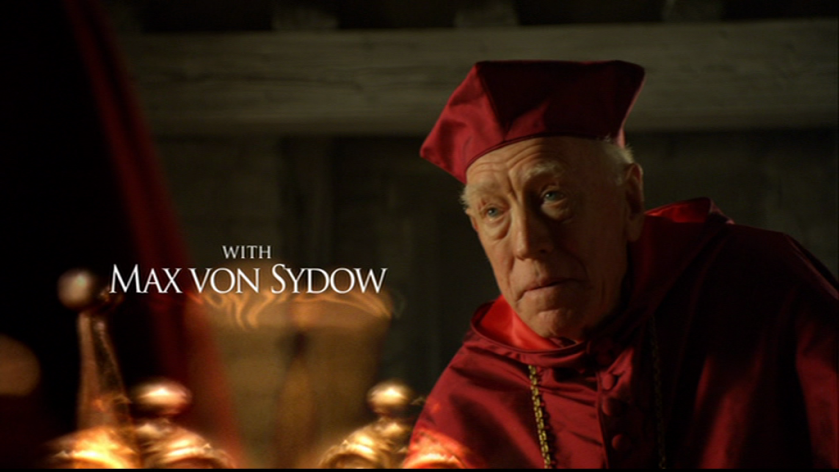 If you want to see an example of the credits (which can change through a season depending on how many guest stars are appearing in a given episode) for Season 3 then one is available here.
If you want to see an example of the credits (which can change through a season depending on how many guest stars are appearing in a given episode) for Season 3 then one is available here.
2019 wasn’t the first year someone pulled off a cast and focus change and wondered if the audience would take it. The Tudors was trying it (albeit a lot less completely than The Crown) back in Aught-9.
So what I’m saying is this: It’s January 1st 2020. Game of Thrones reference futures are so low they are stealth references now, The Crown reference futures are way up but only holding after a solid but slightly flat Season 3, Brexit reference futures are still inexplicably sodding current, and I’m ready to judge the hell out of an excellent TV series, where I know I will find one.
To go where filmed adaptations of the period have very seldom gone before – if it’s film or TV then an awful lot of them end at the death of Anne Boleyn and a title card. And if they have material past it they’ve normally only got about 4 episodes left.
And that’s such a shame, because there is so much ahead: The great rebellion of Henry’s reign, and what its going to do to religion and society. There’s three Queens this season, including two new ones. Mary starts to come into her own as a political player. Henry’s going to enter the self pity Olympics at one point, and as brutal as he gets in Season 3, the full monster still awaits in Season 4. I’m champing at the bit for Anne of Cleves, Catherine Howard scares me (the scrapping over her legacy is a current and alive fight in history)…
We have 18 episodes left in The Tudors and we are just over half way through. Happy New Season, reader, and let’s begin.
Actually Historically…

The opening scene is Henry and Jane’s wedding. It’s not a bad representation but we’ve got one clear change from the historical record and some stuff we’re heroically talking around, just like they did in 1536.
The point being talked around like its 1536 is that Actually Historically it was still May 1536. Anne Boleyn was killed on May 19th, and the dispensation issued for Henry and Jane to marry (Henry must have banged a second cousin of Jane’s at some point and everyone had become very careful about dispensations so they got one) was signed by Cranmer on the same day that Anne died2. Henry and Jane officially got betrothed the next morning, May 20th, and married on May 30th3. That’s a Queen Consort turnaround time of just 11 days.
It’s something historians like to underline with the story of Galcyon Hone4. Galcyon Hone was Henry’s glazier, and someone found him in Henry’s accounts. At this point of history Galcyon had just been paid the hefty sum of £200 to change a shitload of windows from Katherine’s badges to Anne’s. And, yes, was about to get given the work to change them all to Jane’s badges. Henry might have been a monster to be married to, related to, or to work for high up in government, but for his interior decoration team (particularly the workers involved in personalisation) he was an amazing employer.
The change from history is that Actually Historically the marriage happened in the Queen’s Closet in Whitehall5, not in whatever great building Christ Church Cathedral, Dublin‘s pretending to be this shot.
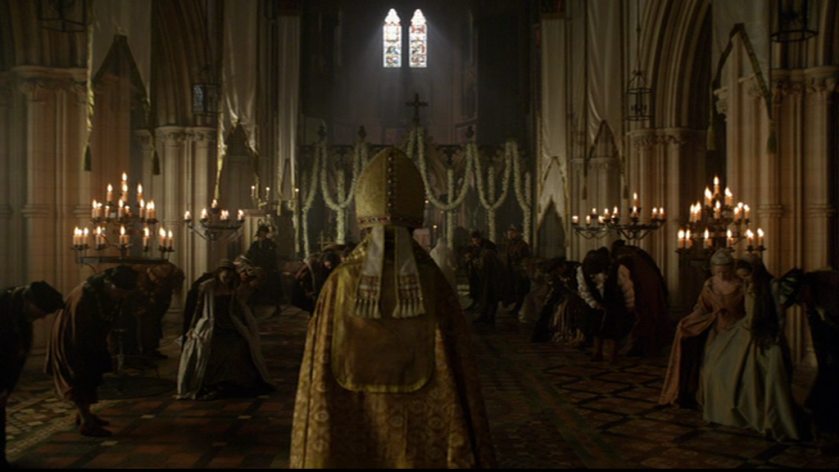

Henry marches up the aisle as his and Jane’s new theme launches. Time for that new season theme moment.
Jane looks beautiful, if a completely different woman this season (Annabelle Wallis). She also looks quite scared and has to remember to drop a curtsey when her bridegroom reaches the top of the aisle.
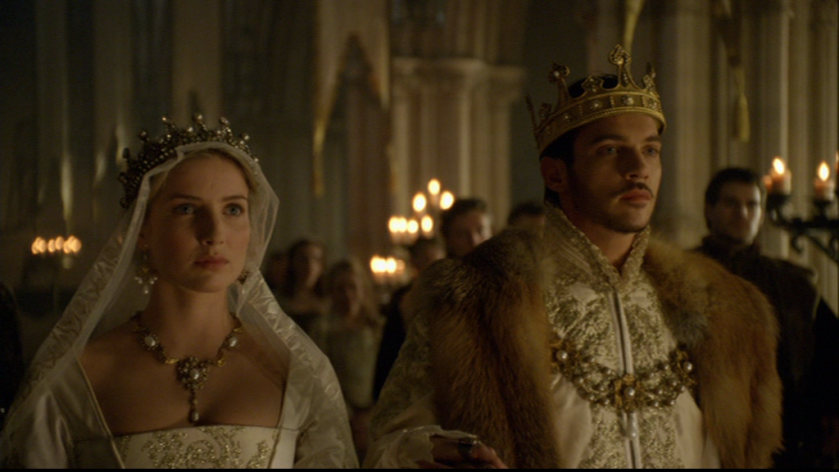
They are married in The Tudors by Bishop Stephen Gardiner, and this is a good opportunity to re-introduce Bishop Stephen Gardiner, who is going to be one of the key players in the back half of Henry’s reign.
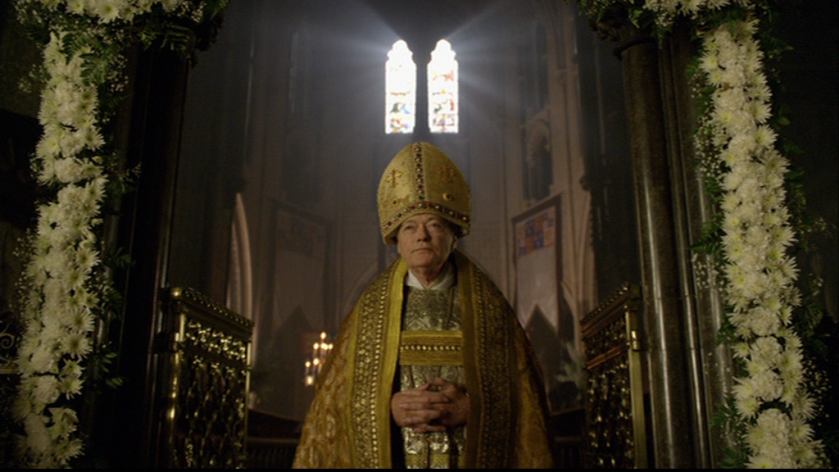
It’s ‘re-appears’ because Gardiner actually appears briefly in Season 1. He was ‘From France’ back in Season 1 Episode 3. Then that character got named as Gardiner when he was one of two lawyers sent to Orvieto to persuade the Pope to give Henry an annulment in Season 1 Episode 7, which is what the Actual Historical Gardiner did during the Great Divorce (He was a church lawyer).
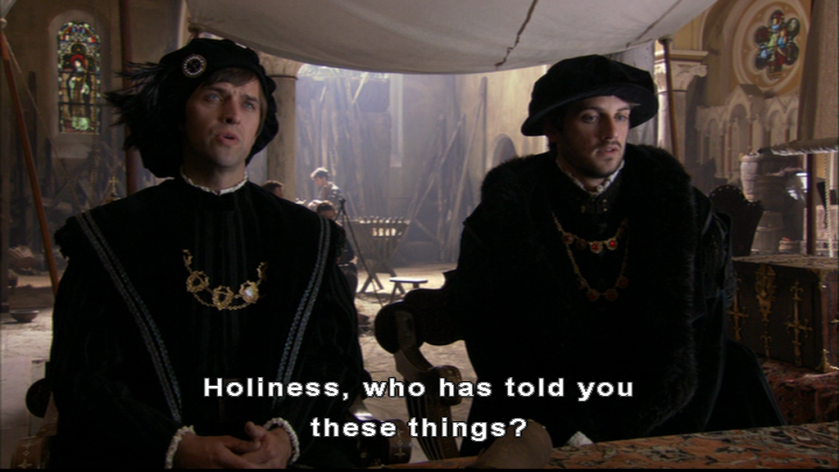
Actually historically he was otherwise strongly conservative in religion and became Cromwell’s greatest opponent still in the government. He lost the power struggle with Cromwell, but Henry wanted to keep him in play and valued his personal loyalty so Gardiner went into honourable exile with a series of diplomatic posts. He starts to pop up at significant moments now, but really comes into his own in Season 4.
He asks the ‘If anyone knows of any just impediment’ question, we see Cromwell look a bit worried, Brandon and his wife clearly happy with events, and Henry? Henry looks like a guy that’s put an awful lot of work into the last decade making sure that his marital status is whatever the hell he says it is.
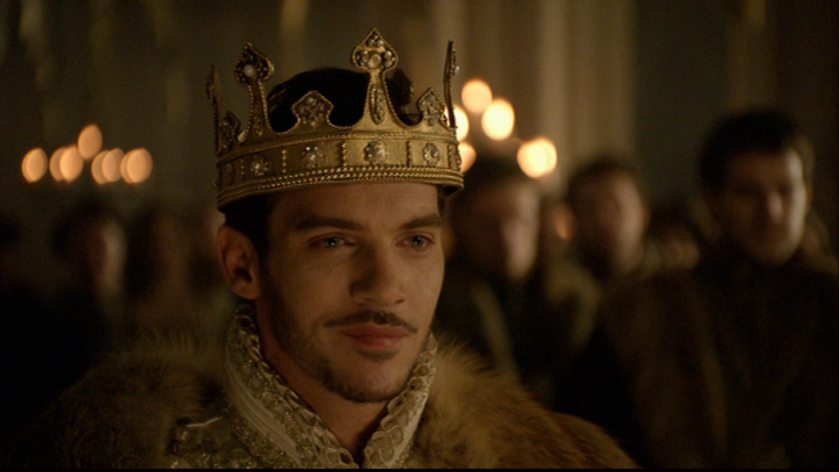
Fortunately no one wants to point out that his man, who has been officially and publicly married for nearly 27 years to two different women, who has raised two children in wedlock (and one outside, his illegitimate son the Duke of Richmond by Bessie Blount was still Actually Historically alive, although not for much longer) somehow every one of them are bastards, (but in a way that is in no way Henry’s fault, of course) that this man, Henry VIII of England in 1536, fresh from killing wife number 2 is clearly a bachelor on the eve of married life for the first time ever.
That’s where the official line is, and I would strongly recommend being aware of it. If you want small talk for the reception I’d stick to how good the hall looks and maybe say something about the weather, and how happy everyone seems. And don’t get too drunk, there are things you really want to remember to talk around here.
It might, for example, occur to you that the court seems empty compared to the last time you were here. You need to think through the implications of that and then not say it out loud. That kind of thing. OK? Right… Ready? Great. Here we go.
Clear, Bright Morning
There wasn’t an Actual Historical ‘wedding reception’ after the wedding as we would understand it but, once a little time had passed and Henry felt safe he was getting away with his wife-swap there was a whole summer of events that year showcasing his new Queen and new marriage6.
And the Main Hall set looks fabulous.
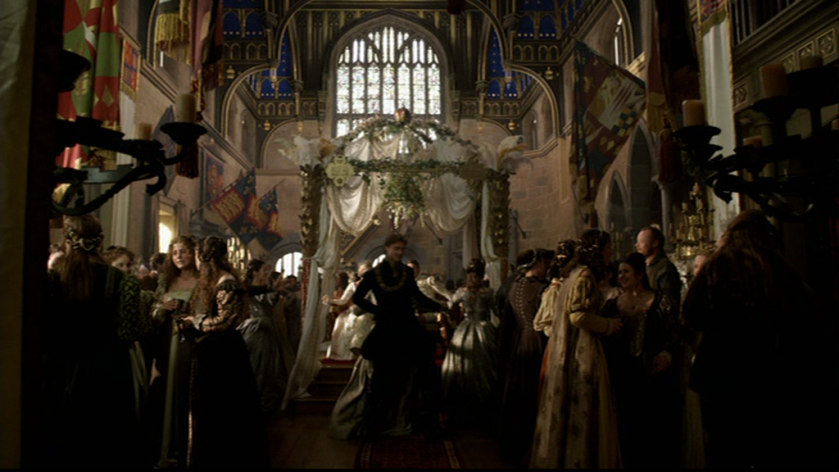
Daytime hasn’t been a standard look for it recently and it really sets off the gold.

Everything is bright and massively accessorized in white and red and more gold.
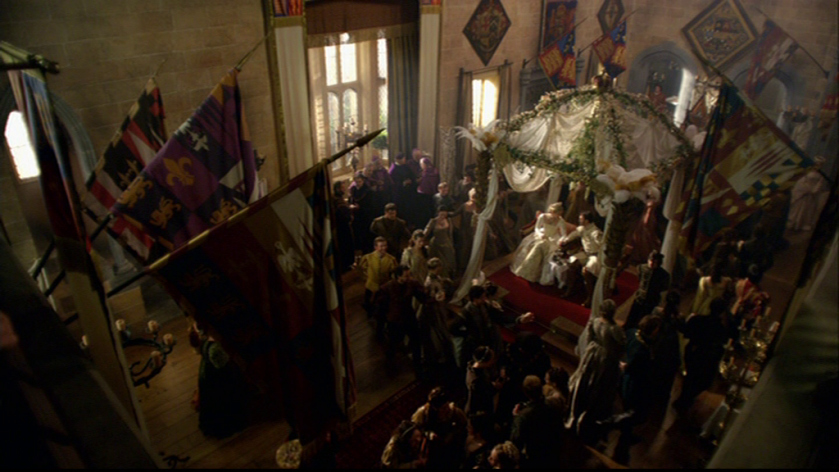
Right, well, lets get around the court and find the state of play.
Henry and Jane join the dance along with the Duke and Duchess of Suffolk, Charles and Catherine Brandon. The Suffolks get a personal moment to assure us that their marriage has stabilised and is in a much better place than we left it after Charles’ French harlot encounter of Season 2. Their other significance is that as prominent Remainers they are delighted and optimistic right now.

Yes. I should point out that the Suffolks have never been the ‘reasonable expectations’ couple of the court, but they do represent the attitude of their faction (Brandon once again stepping in for the absent ‘Catholic but loyal to Henry’ Duke of Norfolk in the storyline) quite well. It was a moment that contained a lot of hopes for Remainers – Anne Boleyn, who had dominated court for a decade was dead and now everyone agreed she had been a wicked harlot that had bewitched the King, so surely with good Queen Jane some (maybe a lot) of it would start to change back. Also, the Remainers and the Brexiters were still in an uneasy alliance (where they had joined together to bring down the Boleyns) and there was even talk of Mary getting reinstated to the succession. It must have felt very much like winning.
A very different storyline wanders in the front door, looking confident and sexy and Eyepatch Dude is all about the door immediately.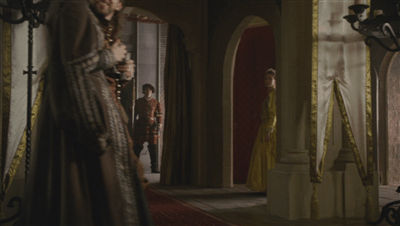
And who wouldn’t be? She’s got a head piece that looks like a shark’s jaw with pearl teeth, that dress is slaying an otherwise suddenly muted room and just take in that entrance, with it’s hand on hip, “Hello Royal Court, Impress Me” Swagger.
She is Lady Ursula Misseldon (Charlotte Salt) , and she’s a fictional character that’s also an amalgam of the ladies of the court Henry had affairs with, or publicly admired while married to Jane. While Henry and Jane were married under eighteen months he did have affairs in that time and with the pressure to emphasise the happiness of marriage number 3 they tend to get swept clean away in adaptation. There are a few great historical stories about those (sometimes unnamed) women and the character of Ursula is going to get them.
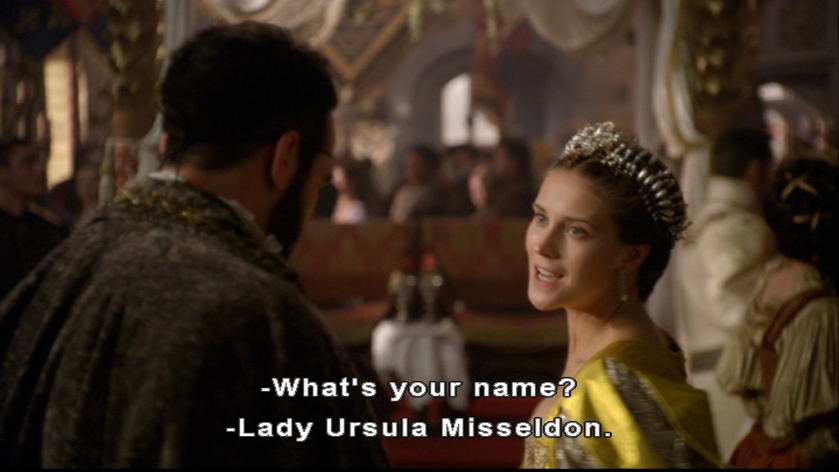
Her counterpart who basically just planted himself across her path and demanded her life history is Sir Francis Bryan, a character based in an Actual Historical person.

Every season The Tudors decided on a set number of storylines it was going to follow, it is part of what kept the pacing so tight. It also trimmed its cast according to the stories it was telling each season and some of the secondary cast end up having to be multi taskers. Characters like Sir Francis and Lady Ursula often have to take up storylines of Actual Historical characters that aren’t being included, or non-historic business for character or plot reasons.
Sir Francis Bryan (Alan Van Sprang) is someone that if we were going Actually Historically we should have met in Season 2, and deserves his confidence as, Actually Historically, he was a man connected to both Boleyn and Seymour factions, but vaulted from the Boleyn faction to the Seymour faction long before anyone else did, executing a perfectly timed turn in Tudor politics. He was known as a rake and a libertine as well as someone who used ciphers, so when The Tudors needs him to multi task as a spy later in the season Sir Francis will be ready.
He also runs close to his Actual Historical roots and is a pretty pure pragmatist which, in a court full of convictions makes him interesting to watch. All the same, I wouldn’t trust him with an Actual Historical storyline without checking on him. He and Lady Ursula do all they need to do to assure themselves of Tudors’ screentime and my attention.

Well, I’ll definitely be watching with a notepad.
Back to politics on the margins of the room and feeling far less sexy and they know it are Cromwell and Rich of the Reformers/Brexiters faction, who weigh up their current state and they have no time for small talk as they positively vault into an amazingly efficient summation.  Cromwell is more confident in the King’s support than Rich. Actually Historically the Protestant reformers were very nervous just now (The last time they changed Queen, it changed everything) and being a wordy lot, a lot of them were writing letters to Cromwell. In The Tudors it appears that the character of Cromwell responds to that pressure by becoming even more zealous.
Cromwell is more confident in the King’s support than Rich. Actually Historically the Protestant reformers were very nervous just now (The last time they changed Queen, it changed everything) and being a wordy lot, a lot of them were writing letters to Cromwell. In The Tudors it appears that the character of Cromwell responds to that pressure by becoming even more zealous.

The music comes to an end, there’s a general ‘aaah’ing from the guests as confetti, in Tudor red and white, falls upon the smiling, happy couple.It is a new dawn for England.
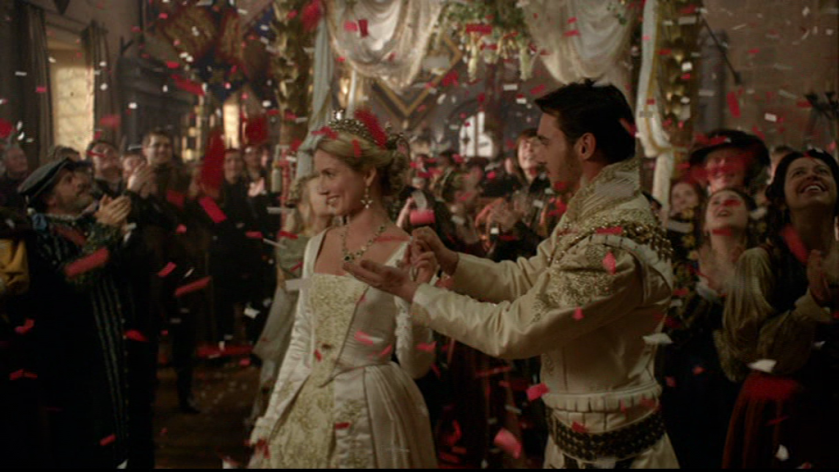
Consummation Preparation
We cut to upstairs where preparations for the ‘main event’ Tudor succession wise involve several priests, one blessing the sheets with holy water, and Bishop Gardiner praying over Jane. Bishop Gardiner is happy to pray you something with a bit of heavy subtext, 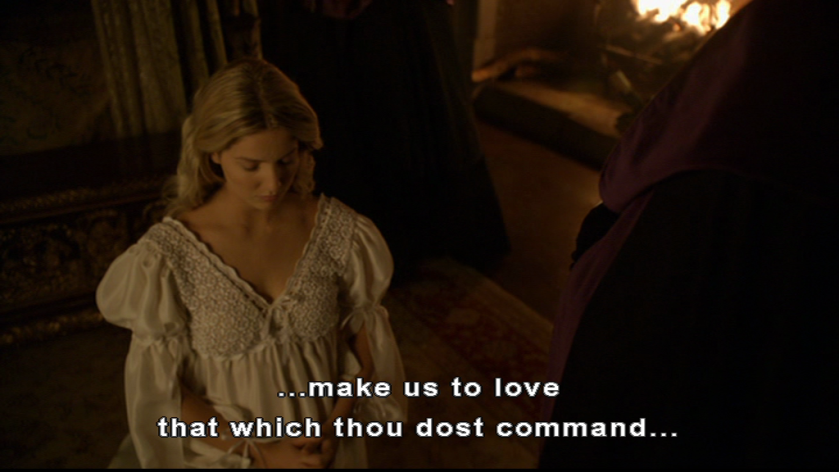
and canny devil that he is, uses the moment to sound out Jane’s religious views. He has a gift for Queen Jane, a crucifix that used to belong to Queen Katherine of Aragon… And in her warm smile and thanks I think he finds what he was looking for. Henry comes in, the camera pulls back and we see quite a few of her maids are also in the room. Henry says there’s no reason to proceed in public –
And in her warm smile and thanks I think he finds what he was looking for. Henry comes in, the camera pulls back and we see quite a few of her maids are also in the room. Henry says there’s no reason to proceed in public – 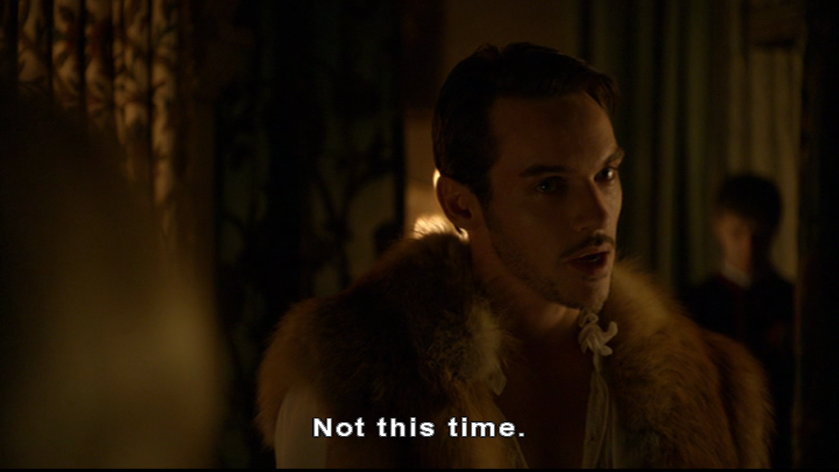 Except Henry never ‘proceeded in public’ so maybe this is about 3 marriage Henry trying to give 6 marriage Henry swagger:
Except Henry never ‘proceeded in public’ so maybe this is about 3 marriage Henry trying to give 6 marriage Henry swagger:
“It’s OK Jane, I could totally have sex in front of all these people, and in fact would normally, but I’m not going to do that so, You’re Welcome”
Everyone leaves, and Henry and Jane are quite sweet together.

While we resist the urge to poke the royal couple a bit to make sure they are not just stuck or something, our ass is whipped to Yorkshire.
Power is a curious thing, My Lord
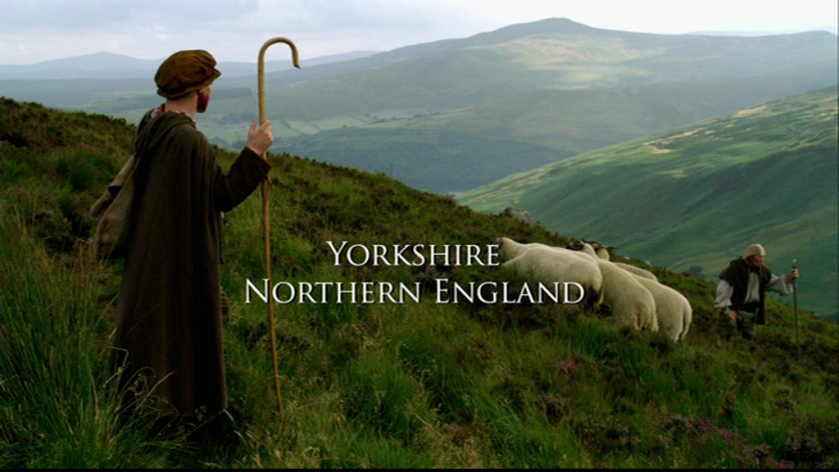
We don’t know the younger shepherd with the port wine birthmark on his face yet, but we will. He is one of the perspectives from the commons we’ll get to see through on this first ever serious attempt to adapt the great rebellion of Henry’s reign to film.
The Pilgrimage of Grace, (Which forms the large part of what Historians are currently calling ‘The Early Tudor Crisis‘) needs to happen when an adaptation carries on past Anne’s death. If you’re going further than that, and it’s not many adaptations that do, this rebellion has massive consequences and cannot be avoided entirely. But it happens almost entirely off screen and with the broadest of brushstrokes unless you’re The Tudors. The Pilgrimage is huge and complicated and messy, and far away from our usual locations, with no current major character in the North until the royal army arrives. It’s going to be worth remembering, as I point out the numerous ways it gets things wrong, or chooses to change them that The Tudors is the only filmed dramatic adaptation ever to really try to show this in any detail.
From his high vantage point the young man sees something happening at Sawley Abbey, and far below, three men ride in to the abbey at speed. They are Cromwell’s men, and they are here to strip the assets…sorry ‘officially dissolve’ it.  And Sawley Abbey was noted to be a particular scandal, because there was nothing official about it. Sawley was officially a ‘large’ abbey and the law for suppressing those hadn’t gone through yet, just the law for small ones worth under £200 per year. But Henry and Cromwell got a particularly sweet deal for Sawley Abbey, swapping it for a Northamptonshire Estate Henry wanted 10, and Henry could get very greedy about land he liked. So they suppressed it in May, before they legally acquired the rights to be able to do that. All the locals got to see their popular local abbey get illegally ransacked so it could be given to a noble for something Henry wanted far away. And, looking ahead, it was the shape of things to come.
And Sawley Abbey was noted to be a particular scandal, because there was nothing official about it. Sawley was officially a ‘large’ abbey and the law for suppressing those hadn’t gone through yet, just the law for small ones worth under £200 per year. But Henry and Cromwell got a particularly sweet deal for Sawley Abbey, swapping it for a Northamptonshire Estate Henry wanted 10, and Henry could get very greedy about land he liked. So they suppressed it in May, before they legally acquired the rights to be able to do that. All the locals got to see their popular local abbey get illegally ransacked so it could be given to a noble for something Henry wanted far away. And, looking ahead, it was the shape of things to come.
So pressing ahead, a lot of the time, wasn’t amazing PR. This action festered, and one of the first things Yorkshire rebels would do when they rose would be to put the monks back in Sawley Abbey 10.
That won’t happen until October 1536, and it’s summer so we’re still at the fomenting stage. Robert Aske is watching from close by, which is not Actual Historical. He’s not that Actual Historical himself yet, either. Robert Aske was born around 1500, making him mid thirties at the time of the rebellion, he was single, and he was another guy with an actual historical eyepatch11 (They fought a lot with pointy stuff and had no antibiotics back then). 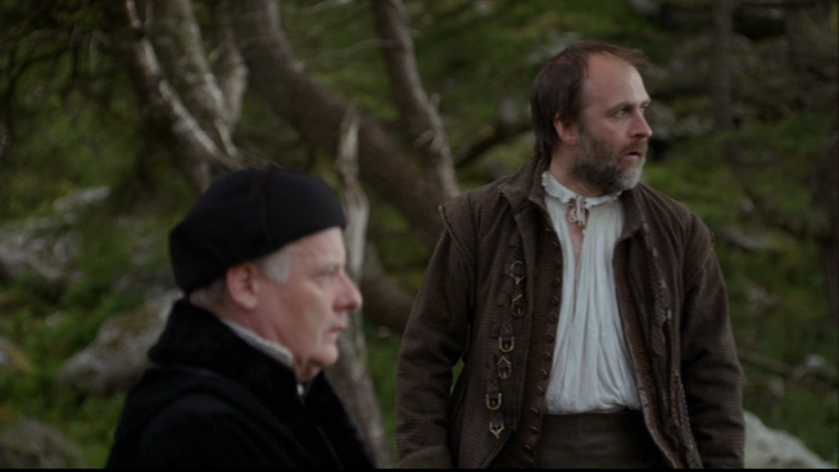
Gerard McSorely gives a great performance so I can live with him being older, his fictional family humanises him, and you just can’t introduce two new characters with an eyepatch in a single episode. Also an eyepatch is coded ‘exiting and daring’ in drama, and The Tudor’s Robert Aske is definitely a small ‘c’ conservative kind of guy. We’re just meeting him, we don’t need conflicting visual signals, too.

As Aske watches the ransacking of Sawley Abbey, binocularly, he’s a little surprised to be approached by John Constable. John Constable is another rebel leader and an amalgam character, probably somewhere between Sir Francis Bryan and Lady Ursula Misseldon in terms of historicity. He’s certainly a character representing a lot of people in the rebellion and with a lot to do for the plot, but most of the time he’s based on Robert Constable, who joined the rebellion after Pontefract, had served extensively in Henry’s wars, and who Aske worked with closely12. John Constable is played by character actor Kevin Doyle.
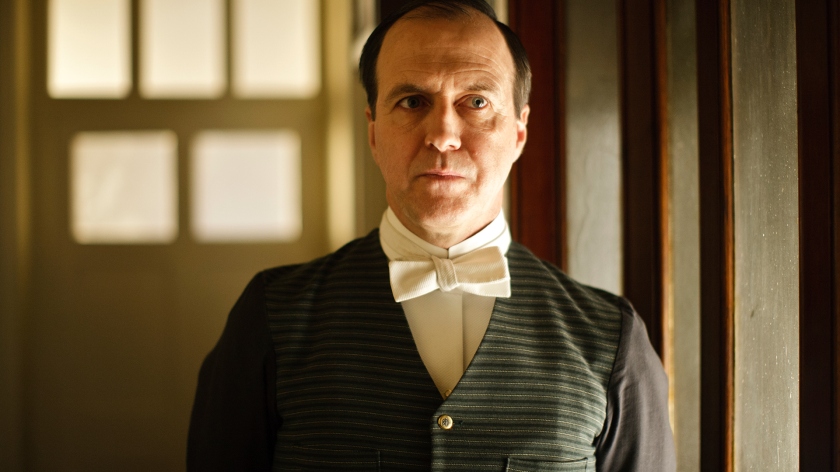
He’s trying to get Aske to join up. He’s a very good recruiter, and when Aske is hesitant, he gets him to take the smaller step of coming to a meeting instead of pushing him. 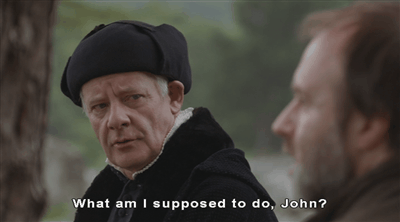
They didn’t meet here, and according to the history they weren’t active in the rebellion until after the Lincolnshire risings (which started 1st October 1536), but we needed to meet at least some of our rebel leaders early, and at the meeting we’re going to learn a surprising amount about the causes of the Pilgrimage.
2DOR Reformation Status Meeting
Meanwhile, back in London, Cromwell is examining the latest acquisition for his ‘clerical fraud’ collection. When Richard Rich arrives, he shows it to him.
Rich tells him that the bill for the larger monasteries to be dissolved has now gone through Parliament and they have commissioners working in nearly every county in England. Given what we’re seeing in the North, Cromwell’s reaction to Rich saying there has been less opposition than expected seems a little blind. 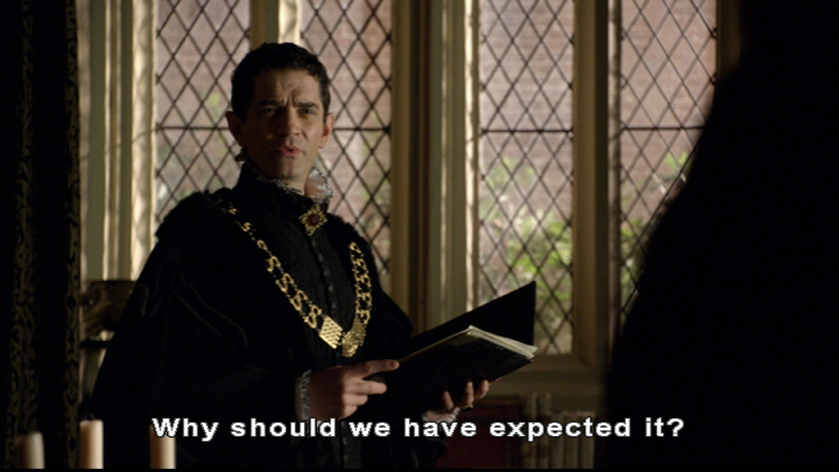
which leads him into another round of ‘What’s wrong with the church today.’
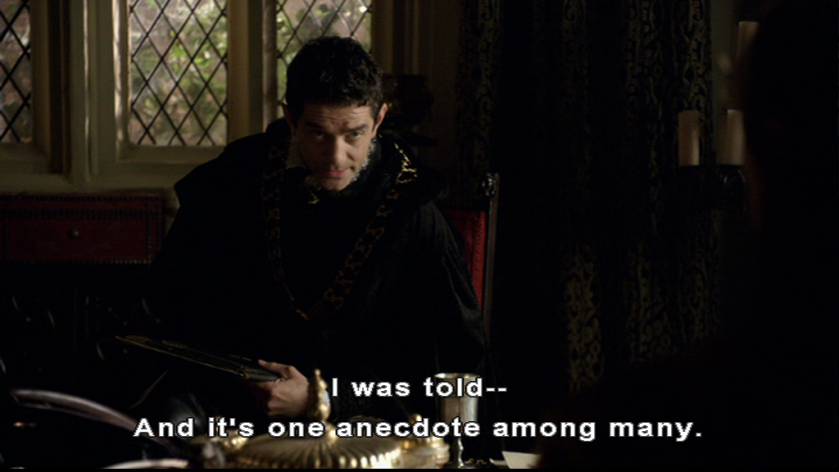
And, yeah, Cromwell is in a bit of a bubble. Most of the people he meets work for him or are scared of him, possibly both, which is also where he gets his information, so you can see he’s become someone who’s viewpoint doesn’t get challenged a whole lot. Particularly because it seems that as long as the money keeps flowing, Henry is happy.
There’s good news on that score, they’re getting whole new orders of money in.

On the day when I hear that something is worth a quadrillion in currency, I’m going to look a lot like Cromwell did here. They’re making hard to comprehend money.
Inner Circle
And we go to the presence chamber to see Henry at work. He’s joking around with Brandon at the beginning, so apparently their relationship remains on an upswing. Sir Edward Seymour, Jane’s older brother, gets announced and he is here for an Actual Historical new title. He is to be Viscount Bechamp of Hache. And like the very oldest and poshest of English titles the names are Norman French put through an Anglo Saxon washing machine for a few centuries and so you have to learn to pronounce it (Vicount Beecham of Hash).
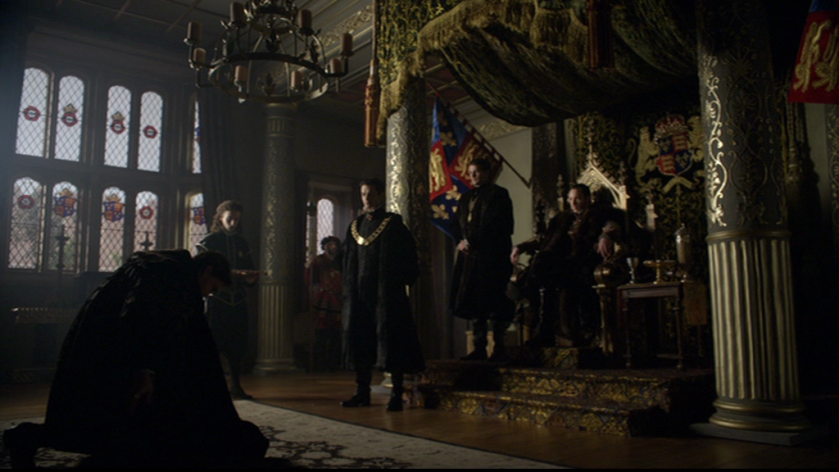
Let’s review.
King>Prince>Duke>Marquis>Earl>Viscount>Baron
So not bad, not bad, something to work from. He lights up more when the two offices he also gets today are announced, he is to be Governor of Jersey and Chancellor of North Wales so he can look forward to being quite important and rich.
He gives a perfect courtly thanks, getting in gratitude, humility and a promise of hard work of which Henry is quite dismissive.  And it’s a decent indicator of how their relationship works, going forward. Edward Seymour is never someone Henry seems to warm to in The Tudors, but he will be someone that Henry finds out he can rely on, and a really skilled courtier.
And it’s a decent indicator of how their relationship works, going forward. Edward Seymour is never someone Henry seems to warm to in The Tudors, but he will be someone that Henry finds out he can rely on, and a really skilled courtier.
Cromwell presents Edward with the paperwork, after that Henry calls over Cromwell, who is organized enough that he’s figured out a kind of ‘morning briefing’ procedure for Henry. That’s good, because Henry really wants to get through this.
Warming relations with the Holy Roman Empire and a friendly letter from Emperor Charles gets a rapid: “Good, what else?”, and then we come to the turning point. Hopeful Remainers were looking for Mary to be named heir again, certainly a return to royal favour was expected, now that the wicked stepmother was dead.
But No, that’s not what is going to happen at all, and you were right to keep your mouth shut at that reception.  Brandon takes it all quite stone faced – he doesn’t appear pleased with Henry’s treatment of Mary but he’s not going to say anything about it either. Once Henry has gone, Cromwell goes over to Sir Francis Bryan, eyepatch dude, and tells him he’s been made a Gentleman of the Privy Chamber – these were personal servants to the King and quite powerful posts. Francis Bryan thanks him pointedly enough that we see he’s clearly affiliated himself with Cromwell. And in this he is also playing the Actual Historical parts of Thomas Heneage and Ralph Sadler, all three were allies of Cromwell that he placed in the Privy Chamber at this time. Then Cromwell says he should have a job for Sir Francis, soon.
Brandon takes it all quite stone faced – he doesn’t appear pleased with Henry’s treatment of Mary but he’s not going to say anything about it either. Once Henry has gone, Cromwell goes over to Sir Francis Bryan, eyepatch dude, and tells him he’s been made a Gentleman of the Privy Chamber – these were personal servants to the King and quite powerful posts. Francis Bryan thanks him pointedly enough that we see he’s clearly affiliated himself with Cromwell. And in this he is also playing the Actual Historical parts of Thomas Heneage and Ralph Sadler, all three were allies of Cromwell that he placed in the Privy Chamber at this time. Then Cromwell says he should have a job for Sir Francis, soon.
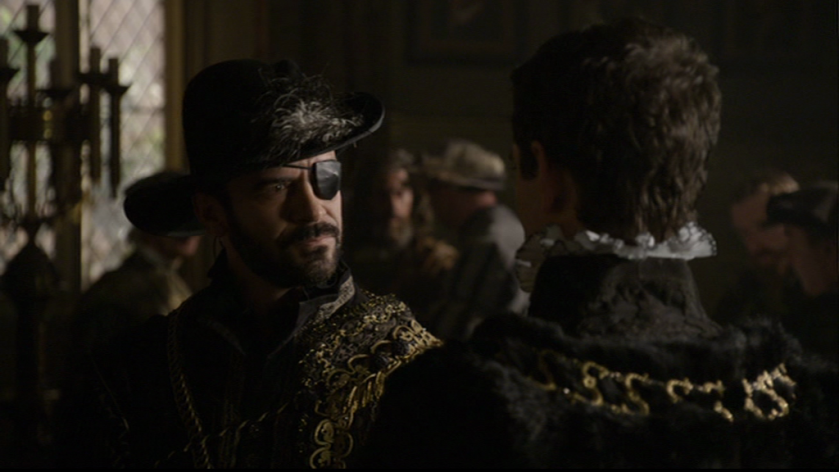
We follow Henry, who has marched around the corner to find Chapuys. This is by design, apparently, because he wants to introduce Chapuys to Queen Jane for her first ambassadorial interview. Henry introduces them, and Queen Jane does not look delighted with Henry throwing her at an important ambassador and walking right out again. He retreats out of the room but into a spying hole so Chapuys and Jane are in for a bit of a test.

It’s an Actual Historical encounter, recorded by Chapuys. It differs a little, in that Henry didn’t go to a hidey hole and spy on them, he went to another part of the room to talk with Queen Jane’s ladies in waiting while they talked. It all starts fine.

Throughout Jane does really well, staying measured and being as general as possible even when Chapuys presses for support of Mary quite a bit harder than he should.  And Jane is a little perturbed by her new husband’s chucking her in the diplomatic pool, but the good news is she aced the test. Not that she’ll get so much as a “Well Done” for it or even an explanation from Henry. Chapuys didn’t pass, pressing for Mary at the expense of the potential sons Henry’s going to have now, and he gets some quite belligerent royal sarcasm outside. Henry turns the conversation so he can say how Queen Jane might want to use her influence to stop him entering a Foreign war. Chapuys is suddenly very intent – what war is Henry talking about? But it’s a feint so that Henry can say he’s been talking hypothetically.
And Jane is a little perturbed by her new husband’s chucking her in the diplomatic pool, but the good news is she aced the test. Not that she’ll get so much as a “Well Done” for it or even an explanation from Henry. Chapuys didn’t pass, pressing for Mary at the expense of the potential sons Henry’s going to have now, and he gets some quite belligerent royal sarcasm outside. Henry turns the conversation so he can say how Queen Jane might want to use her influence to stop him entering a Foreign war. Chapuys is suddenly very intent – what war is Henry talking about? But it’s a feint so that Henry can say he’s been talking hypothetically.
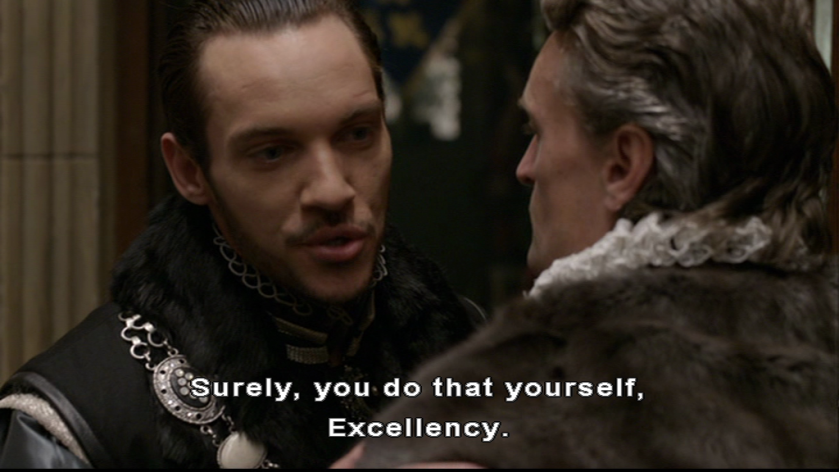
Henry’s having a bit of a flex, but in the North the commons are assembling.
Are you fond of riddles?… Why? Am I about to hear one?

There were 4 basic classes in English society of this period. And the trick was not to piss them all off at once.
First, The Nobility were wealthy landowners that held titles, from Duke to Baron. Lord Darcy, when he appears, will be an example of a member of the Nobility that joined the rebellion, and for every noble the rebellion got it also got legitimacy, large amounts of resources and sometimes strategic advantage as well.
The next two classes, Gentry and Middle Class co-mingled quite a lot. Gentry was, literally, distantly related to Nobility. Gentry meant you were from a noble family – you may well have a coat of arms, the family held land, and someone in your family had held a title at some point, but it wasn’t you. They mingled with the Middle Class, ‘No-one’s ever had a title but we’ve got money’ (like the Boleyns before they started marrying up) who were basically merchants and wealthier kind of farmers, and both the Gentry and the Middle Class produced the lawyers, soldiers and other professionals the country now increasingly needed in order to run. Robert Aske, John Constable, and Sir Ralph Elleker were all examples of the Gentry in the rebellion, and they provided vital expertise and organization.
Finally the Commons, or the Working Class. Very few members would own property and if they did it would be small. Workers in proto-industries might have been doing a bit better than agricultural workers, and if you didn’t have a job you had a decent chance of starving, but that’s about it for layers in this class. The most vulnerable and numerous segment of the population, they would die in thousands in every rebellion, but dwarfed everyone else in terms of manpower.
John Constable introduces Aske to this meeting of the commons in a part of Yorkshire, saying that they should know him from being the Earl of Northumberland’s legal man.
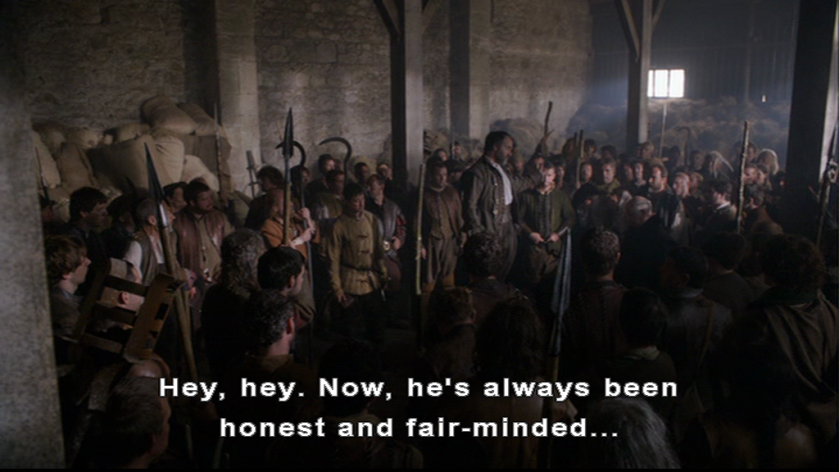
The Earl he’s talking about is Harry Percy, Anne Boleyn’s ex and Aske’s second cousin, who actually historically employed Aske briefly in 1527 before Aske got admitted to Gray’s Inn in London20 (he qualified to study the law there). And generally speaking the Actual Historical Aske comes across as more politically connected and more well-travelled than his version in The Tudors. He got caught up in the rebellion while travelling back to London from Yorkshire for the start of the new law term21.
You get a pretty good run through of the main causes of the Pilgrimage in this scene, as Robert Aske asks the commons what their grievances are. And what’s the first one up?
Abolishing Holidays

The word Holiday comes from Holy Day. In the beginning, we got our time off from the Church (They always wanted a part of it, but they got it for us). The commons (or peasants), lived on very narrow margins and with few rights. The North was poorer than the South, and its economy was even more centered around agriculture.
For an agricultural worker it could be fantastically hard labour for incredibly long hours (as long as the daylight, sometimes more) during harvest, and they got a few extra days to rest up and eat well in that period because the Church had said so and whatever local lord they had couldn’t gainsay that.
And then Cromwell and the King did gainsay that, took a load of holidays away, and aggressively pissed off the single largest section of society. However for this grievance, the more affluent you were, the less it affected you.
The next one, the big one, affected everyone.
The Church and The King’s Advisors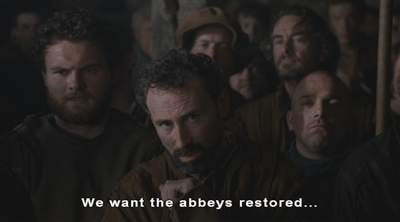
The dissolution of the Abbeys wasn’t that popular in the South. In the North it was widely reviled. Faith in Roman Catholicism was much stronger in the North, there were a lot more Catholics from bottom to top in society, and their faith had been, and was being attacked.
A lot more of their local Abbeys were serious about their charitable mission in the North22, more of a part of the communities they were set in. If they had a treasure in their vaulted halls, most locals would have seen it. The arguments Cromwell used in the South – of insular religious houses hoarding treasures and living dissolutely did not ring true for people of the North, largely they knew and worked with their local religious communities. Finally, The North was a poor part of the country and having a rough time (at least one bad harvest in 1535) when the dissolution started. The charity those abbeys provided was sorely missed, and what was being looted from them was benefiting the King, and nobles in the South.
The defence of their religion was the uniting factor in the rebellion.
As for the replacement of Henry’s ministers, well there’s some ways to see that. The demand for the removal of Cromwell and Cranmer is both a great way of actually rebelling while still being able to say you’re not rebelling against the King, and an backhanded offer of a way out for Henry…should he ever want to….you know, just blame Cromwell and Cranmer and step back from the whole thing. It could all be that easy, Your Majesty, and if you execute them, then we’ll know you can’t go back.
Everyone agreed on the next one, too.
Sodding Taxes
Let’s say you’re a tenant farmer in the North, trying to climb the mountain so your son can maybe someday own a smallholding and start climbing his mountain, maybe one generation will one day make it to the Middle Class. Hard as it would be, anyone trying it in the North of England also had to do it while not getting robbed blind by everyone with more power than them, and in the 1530s that was quite a trick.
We’ll start with a big one, an underlying cause that was triggering economic instability for most of this century. They might not have understood economic inflation, but their economy had a bad case of it. You ask a Tudor Historian anything about what things cost and they’re going to tut and ask where and when because the difference it can make is huge.
The people in this era lived on narrow margins, and long term, in the background, general economic inflation was magnifying the effect of everything else.
Henry being short of money meant that over the years his tax collection had ramped up in efficiency. Small taxes which had been around for centuries were suddenly collected regularly and with vigour and had gone from being an occasional part of life to regular and resented. Land enclosures (common land you and others used to graze your sheep suddenly belonging to a local lord because he said so and put a fence up), and sudden price hikes (In Northamptonshire there was a case of a demand for Gressom -a name for a payment at the start of a land lease, that had gone up from six shillings and change to thirty shillings in one jump23) were getting widespread by the 1530s and could devastate your income for years. And a land tax called ‘The Subsidy’ which was originally used for defence expenses only had been extended to be used for whatever Henry wanted in 1534. He could spend it where he wanted and that also meant he no longer had to point at a war or an imminent threat to be able to collect it24.
The North’s taxation was normally low, bottom to top, not just because it was poorer, but because it regularly had to raise troops for active service against raids by the Scots. As Henry got short of money and Scotland had not been causing serious trouble for a while, this was being forgotten, and the economy just couldn’t handle the same taxation as the South.
At the top end economic unease was also caused by another innovation from Henry, The Statute of Uses, which got the monarch right back in the middle of land inheritance (all England technically being property of the crown). It might have been sorting out some problems with land law but Henry and Cromwell passed it to start taking a cut of those inheritances, and as rapacious and unstoppable as Henry was being with Church land, that made the upper sections of society very nervous.
The Spark
Last on the list comes from the Harry Enfield looking dude, who has heard some gossip.  It would be this rumour that finally set off the rebellion, in Louth, Lincolnshire at the beginning of October 1536. It wasn’t entirely without foundation either. There were some commissioners that were out and reporting to Cromwell not on abbeys but on the general clergy25. Perhaps they were like ones sent out a few years earlier to compile the ‘Valar Ecclesiasticus’, and that had ended up in the dissolutions they were going through now.
It would be this rumour that finally set off the rebellion, in Louth, Lincolnshire at the beginning of October 1536. It wasn’t entirely without foundation either. There were some commissioners that were out and reporting to Cromwell not on abbeys but on the general clergy25. Perhaps they were like ones sent out a few years earlier to compile the ‘Valar Ecclesiasticus’, and that had ended up in the dissolutions they were going through now.
Parish churches were very different to abbeys, most of their treasures would have been bought by prominent past members of the community and were seen as property of your town or locality. You would see them every Sunday or Holiday. So when, nine days before the rebellion, one of Cromwell’s lesser officials was heard in Louth to say that ‘A silver dish with which they went about to beg for their church was more meeter for the King than for them’, it was not taken lightly. Someone drew a dagger,26. The next day, parishoners took the church keys away from the church wardens and would guard the church in shifts for more than a week.
They were angry and ready to fight. And so are our group of commons in The Tudors. When Aske speaks, he’s not ready yet. He will not go against the King. The commons are bloody annoyed, its not what they wanted to hear, and they are done doffing their caps right now.

Aske is going to need a bit of a soul search before he commits, and it gives the Lincolnshire rising time to start up off screen.
The Return of the Infamous Lady Rochford
Ladies, I am boiling. My blood is simmering through my veins, and I have some things to say. About headwear. And choices. 

Anne Boleyn’s travesty has been refurbished and has returned to continue to perplex us. It does look less like it’s been attacked with a glue gun and flying tat this time around, but restraint has not made the design actually appealing. Also, Queen Jane has done something extraordinary to the headgear for her ladies in waiting.
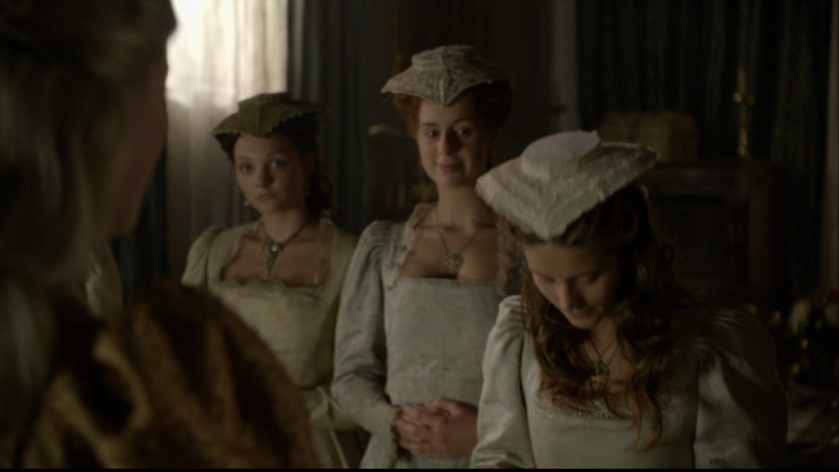
Well, Queen Jane Seymour was an advocate of terrible fashion, putting a lot of time and effort into bringing the gable hood back, so it’s not inappropriate.
Queen Jane is swearing in Ursula Misseldon, and then takes Jane Boleyn aside.
Queen Jane offers Jane Boleyn a position not only as a lady in waiting, but her principal lady in waiting, out of the goodness of her heart. It’s a nice story, and Queen Jane was kind, but it’s not an Actually Historical one.
Actually Historically Jane Boleyn did become a lady in waiting (not the chief lady in waiting but she was a comparatively high status one as she was still a Viscountess) to Queen Jane Seymour. But there’s no reason to think Good Queen Jane did anything other than agree to it, but as she needed to we know that when they both worked together for Queen Anne they must have got along at least reasonably well. Actually Historically the two people most likely responsible for Jane Boleyn’s comeback are the two people shown as not responsible for it here, Thomas Cromwell and Jane Boleyn herself.
After the fall, Jane Boleyn, a childless widow with no money on the wrong side of a monumental scandal, was not someone with political or economic value. She was due a jointure, which is like a widow’s pension, agreed and financed like her dowry at the time of her marriage for just this sort of circumstance. Thomas Boleyn, whose circumstances had massively reduced, tripped his way through her jointure agreement, wheeling and dealing, actively misreading some of it to pay her as little as possible, and leaving her to manage, every year, on less than George Boleyn had once paid for a really nice cup30.
Her father Lord Morely had always been quite Remainer, and had come promptly onto the king’s side during the fall of the Boleyns. So he was doing quite well at the moment, getting a new title around this time. Still, he did not intervene for her.
Jane was in a pretty hopeless situation. But she wasn’t rescued from it by Queen Jane’s kindness. She dusted herself off and did something about it. She wrote and petitioned Cromwell, and Cromwell came through for her, raising the matter with the King and sending a letter to Thomas Boleyn that had him jumping to attention31.
Thomas Boleyn significantly increased the pension, and wrote back saying how what he did was totally allowed in the jointure agreement but he was very happy to add this amount. Oh, and to prove that some inter generational arguments are forever had to say that when he was young he raised a whole family on just £50 a year, so…32.
The documentation we have runs out at this point so we can’t entirely know how she got her position back at court, but Jane Boleyn became a client of Thomas Cromwell, and very shortly after that she was back in royal service, walking in places Cromwell could not himself.
We saw Cromwell place Sir Francis Bryan in close orbit of the King earlier this episode. It is entirely possible the Cromwell took this opportunity to put someone who owed him and he knew could do the job, right where he needed them to be, in close orbit of the Queen.
But it all started with Jane Boleyn taking action herself.
Curb Your Enthusiasm
Sir Francis Bryan arrives at what we can presume is Hunsdon House (it would be close to a permanent home for Mary until her accession) to see Mary.

She says she has written a letter, congratulating her father on his marriage, but Sir Francis is not here for ‘such pleasantries’. Sir Francis is once again doing the work of many for The Tudors, here playing the part of an Actual Historical group of councilors led by the Duke of Norfolk33. And maybe it was written that way for a while because Mary mistakenly calls Sir Francis ‘My Lord’ and ‘Your Grace’, two different forms of address, both way above his due as a simple Sir, in this scene.
What no one was expecting for Mary was that, after the death of the woman that had persecuted her for so long, things would actually get worse for her. But that’s what happened.
Cromwell and Mary actually historically gone on quite well. He had stayed well out of Anne’s bullying, and his relationship with Mary was good enough that she would genuinely ask for his advice. They exchanged friendly letters and it seems the first thing Mary noticed was that she wasn’t getting a response. Then this visit happened. 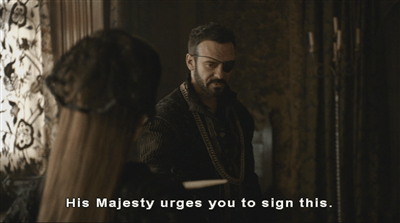 And when she refused they absolutely did threaten her, including the deeply distasteful ‘boiled apple’ threat34.
And when she refused they absolutely did threaten her, including the deeply distasteful ‘boiled apple’ threat34. 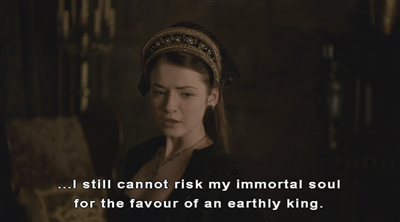 Leaving Mary and the remainer faction to chew on that, Henry has a nice lunch with his new Queen. He wasn’t to know if she’s ever heard of the Bucentaur (State Barge) of Venice, and he talks about it in roughly the way I’m talking about Watchmen, The Witcher or The Mandalorian this year.
Leaving Mary and the remainer faction to chew on that, Henry has a nice lunch with his new Queen. He wasn’t to know if she’s ever heard of the Bucentaur (State Barge) of Venice, and he talks about it in roughly the way I’m talking about Watchmen, The Witcher or The Mandalorian this year.

But Jane has something on her mind distracting her from the awesomeness of Venetian power cruisers. She leans forward, gently apologises, and says that she has heard (it’s got around the faction quick) that Henry might still consider proceeding (legally) against the Lady Mary. And she says that with all her heart she would like to beg him not to.
Oh dear. You can tell darling Jane has gone off script by the way Henry reacts as if she’s just done something horrifyingly impolite.  He has to get up, walk over and whisper it to her in an impressively threatening whisper. So the room won’t hear that terrible mistake you just made, dear. Henry does not want political talk at his personal table and he’s done asking for it. The plus side is that he’s generous,
He has to get up, walk over and whisper it to her in an impressively threatening whisper. So the room won’t hear that terrible mistake you just made, dear. Henry does not want political talk at his personal table and he’s done asking for it. The plus side is that he’s generous,  as long as the present you’re holding out for isn’t mutual respect, because you’re never getting that.
as long as the present you’re holding out for isn’t mutual respect, because you’re never getting that.
And I used to find The Tudors interpretation of Jane Seymour as insipid. More and more she looks like someone trying to survive an abusive relationship.
Link to Season 3 Episode 1 Part 2

So much respect for both Janes here! Jane Boleyn (longtime fave of mine) fighting for what was owed her continues to be inspiring, and it could not have been easy for Jane Seymour to navigate such a precarious situation 24/7. Really enjoy how you cover these; can’t wait to see it continue into the new year!
LikeLiked by 1 person
I really like this Jane actually. It took me a bit to get used to her, but when I rewatch this season, I notice a lot of subtle things she does. There are moments where you can just see her remembering exactly what happened to her predecessor and choosing to step very carefully.
LikeLiked by 1 person